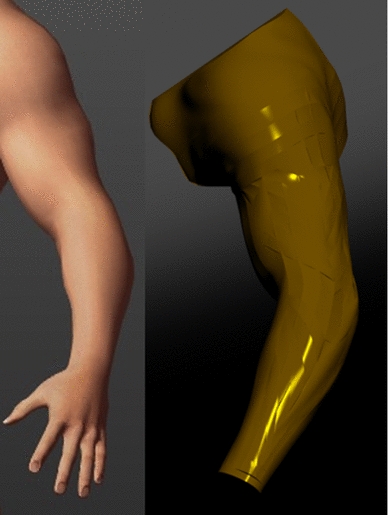Abstract
The elements of a human arm, forearm to upper arm, execute a series of motions to perform certain actions during daily activities. The performed actions are the result of combining the flexion-extension, abduction-adduction in different orders and with different angles. To capture the motions and use them for different applications, the angles for the arm's elements are needed for all three planes, coronal, transversal and sagital, during the motion. The proposed prototype has three MPU6050 IMU sensors connected to an Arduino Uno development board, through a TCA9548A demultiplexing chip, which transmits the captured motion data to a computer that uses MATLAB to post-process the data and simulate the motion in a 3D environment. The system has a reference situated on the spine and two points along the human arm, to capture its motion, the first in the middle of the Humerus bone, and the second is in the middle of the forearm. We've proposed this prototype, not only for accuracy, cost-effective hardware-wise, but also, operating it, represents and advantage, allowing flexibility and ease of use. This prototype has the capability not only to capture the human arm's motion, in real time, but also to discover the natural limits of the motions which a human arm can do. The sets of motion, that follow daily routines for motion, of a person, can be integrated in an exoskeleton's control system, to reproduce scenarios with the help of which possible patients can train themselves, or use in therapy, in order to regain mobility of their arms, that were formerly affected by neuromuscular diseases or physical injuries of the muscles or bones.
Access this chapter
Tax calculation will be finalised at checkout
Purchases are for personal use only
Similar content being viewed by others
References
Panaite, A.F., Leba, M., Olar, M.L., Sibisanu, R.C., Pellegrini, L.: MATEC Web of Conferences (2021)
Wu, Y., Zhao, F., Kim, W., Ajoudani, A.: An intuitive formulation of the human arm active endpoint stiffness. Sensors 20(18), 5357 (2020)
Wittmann, F., Lambercy, O., Gassert, R.: Magnetometer-based drift correction during rest in IMU arm motion tracking. Sensors 19, 1312 (2019). https://doi.org/10.3390/s19061312
Mutha, P.K., Haaland, K.Y., Sainburg, R.L.: Rethinking motor lateralization: specialized but complementary mechanisms for motor control of each arm. PLoS ONE 8(3), e58582 (2013). https://doi.org/10.1371/journal.pone.0058582
Risteiu, M.N., Leba, M.: Right arm exoskeleton for mobility impaired. In: Rocha, Á., et al. (eds.) WorldCIST 2020. AISC, vol. 1160, pp. 744–754. Springer, Cham (2020). https://doi.org/10.1007/978-3-030-45691-7_70
Dunne, J.J., Uchida, T.K., Besier, T.F., Delp, S.L., Seth, A.: A marker registration method to improve joint angles computed by constrained inverse kinematics. PLoS ONE 16(5), e0252425 (2021)
Boulic, R., et al.: An anatomic human body for motion capture (1998)
Yang, Z., et al.: Influences of experience and visual cues of virtual arm on distance perception. i-Perception 11(1), 2041669519901134 (2020)
Ge, S., Fan, G.: Articulated non-rigid point set registration for human pose estimation from 3D sensors. Sensors 15(7), 15218–15245 (2015). https://doi.org/10.3390/s150715218
Rapczyński, M., Werner, P., Handrich, S., Al-Hamadi, A.: A baseline for cross-database 3D human pose estimation. Sensors 21(11), 3769 (2021). https://doi.org/10.3390/s21113769
Spruyt, V., Ledda, A., Philips, W.: Robust arm and hand tracking by unsupervised context learning. Sensors 14(7), 12023–12058 (2014). https://doi.org/10.3390/s140712023
Risteiu, M., Leba, M., Stoicuta, O., Ionica, A.: Study on ANN based upper limb exoskeleton. In: IEEE 20th Mediterranean Electrotechnical Conference (MELECON), Palermo, Italy, pp. 402–405 (2020). https://doi.org/10.1109/MELECON48756.2020.9140691. https://ieeexplore.ieee.org/document/9140691
Panaite, A.F., Rişteiu, M.N., Olar, M.L., Leba, M., Ionica, A., Hand rehabilitation-a gaming experience. In: IOP Conference Series: Materials Science and Engineering, vol. 572, no. 1, Article no. 012092 (2019). https://doi.org/10.1088/1757-899X/572/1/012092
Author information
Authors and Affiliations
Corresponding author
Editor information
Editors and Affiliations
Rights and permissions
Copyright information
© 2022 The Author(s), under exclusive license to Springer Nature Switzerland AG
About this paper
Cite this paper
Panaite, F.A., Leba, M., Sibisanu, R., Olar, M.L. (2022). Motion Sensors Based Human Arm Pose Estimation. In: Rocha, A., Adeli, H., Dzemyda, G., Moreira, F. (eds) Information Systems and Technologies. WorldCIST 2022. Lecture Notes in Networks and Systems, vol 468. Springer, Cham. https://doi.org/10.1007/978-3-031-04826-5_32
Download citation
DOI: https://doi.org/10.1007/978-3-031-04826-5_32
Published:
Publisher Name: Springer, Cham
Print ISBN: 978-3-031-04825-8
Online ISBN: 978-3-031-04826-5
eBook Packages: Intelligent Technologies and RoboticsIntelligent Technologies and Robotics (R0)




